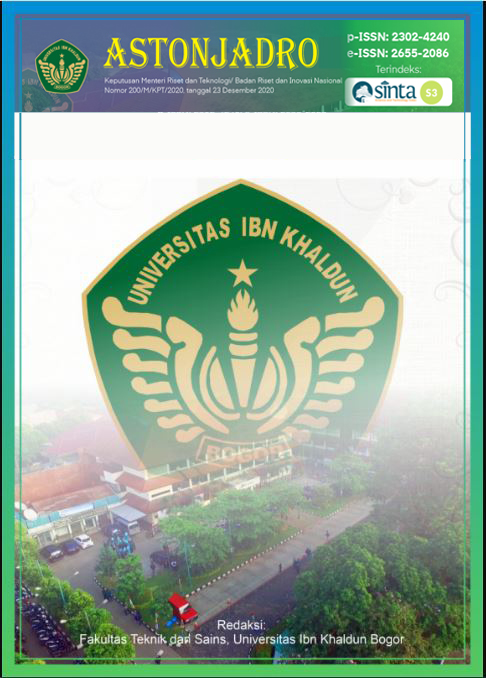Territoriality Characteristics in Housing of Kampung Bugis, Buleleng Regency, Bali
DOI:
https://doi.org/10.32832/astonjadro.v12i1.7909Keywords:
kampung bugis, territoriality, personalization, expansion, space divider.Abstract
One of the less well-organized residential areas in Buleleng is the Kampung Bugis settlement. The development of the Bugis Village settlement as one of the densest settlements in Buleleng does not get good regulation and control so that the village environment tends to be slum, disorganized, uncomfortable and unhealthy. The existence of Bugis Village which is increasingly dense by residents also has an impact on the density of buildings in residential areas. Unfortunately, this condition is not balanced with the arrangement and sufficient land area. Due to the high environmental pressure, residents become spatially motivated by creating "new spaces” to meet their individual needs. This is very interesting to examine so that in the future it can be used as a reference for the development of residential areas in the future. Territoriality characteristics that occur in Bugis Village are as follows, land ownership status does not really affect the formation of territorial boundaries, boundary elements are not always a marker of social identity, space that has the highest privacy always has firm territorial boundaries, space resulting from territorial expansion tends to use semi-fixed elements as a territorial marker. This happens because there is still awareness from the residents of the settlements that the expanded land is legally not their property. The territoriality formed in settlements is generally to fulfill six main needs/activities, namely: drying, gathering/playing, trading, storing goods, parking and socializing. Apart from being a territorial marker, some of the boundary elements are an embodiment of aesthetic needs.
References
Altman, Irwin, 1975, The Environment and Social Behaviour : Privacy, Personal, Space, Teritory and Crowding, Monterey, Brooks/ Cole, California.
Alin, P. dkk. 2014. Teritori Pedagang Informal: Studi Kasus Ruang antara Pasar Johar dan Pasar Yaik Semarang. Jurnal Arsitektur NALAR's Vol: 13 No. 1, Edisi Januari 2014: Hal 1-10.
Burhanuddin. 2009. Karakteristik Teritorialitas Ruang Pada Permukiman Padat di Perkotaan. Jurnal "Ruang" Vol 2 No. 1, Edisi Maret 2010.
Budihardjo, E. 1998. Percikan Masalah Arsitektur Perumahan Perkotaan. Yogyakarta : Gajah Mada University Press.
Edney, J. 1976. Human Territoriality: Environmental Psychology, People and Their Physical Setting. Eds: Prohansky, Harold M. Et.all. Holt. Rinehart and Winston. New York.
Hall, 1966. Environment dan Behavior Planning and Everyday Urban Life, University ofVictoria, British Columbia.
Laurens. J. M, 2004. Arsitektur dan Perilaku Manusia, Grasindo, Jakarta. Budiharjo, Eko 1998. Sejumlah masalah permukiman kota, Alumni: Bandung.
Laurens. J. M, 2004. Arsitektur dan Perilaku Manusia, Grasindo, Jakarta.
Lang. J, 1987, Creating Architectural Theory, Van Nostrand Reinhold Company, NewYork.
Putri, Rr., dkk. 2012. Pendekatan Teritori Pada Fleksibilitas Ruang Dalam Tradisi Sinoman dan Biyada di Dusun Karang Ampel Malang, Jurnal DIMENSI (Journal of Architecture And Build Environment) Vol: 39 No. 2, Edisi Desember 2012: Hal 65-76.
Rapoport, Amos, 1986, The Use and Design of Open Space in Urban Neighborhoods. D Frick (eds) The Quality of Urban Life, Walter de Gruiter and Co., Berlin.
Sangaji, Etta Mamang dan Sopiah. 2010. "Metodologi Penelitian”. ANDI. Yogyakarta.
Widyani, T. I. 2015. Perilaku Teritorialitas Nelayan di Relokasi Perumahan Nelayan Kota Mataram (tesis). Denpasar: Universitas Udayana.
Widjaja, P. 2007. Teritorialitas Domestik Rumah Pada Dua Kampung Kota di Bandung. Bandung: Sekolah Arsitektur, Perencanaan dan Pengembangan Kebijakan, ITB.
Wulandari, N. 2011. Teritorialitas. (serial online), Apr., [cited 2015 Sept. 8]. Available from: URL: http://ninambel89.blogspot.com/2011/04/teritorialitas.html.
Downloads
Published
How to Cite
Issue
Section
License
Copyright (c) 2022 ASTONJADRO

This work is licensed under a Creative Commons Attribution-ShareAlike 4.0 International License.
Paper submitted to ASTONJADRO is the sole property of the Astonjadro Journal. Unless the author withdraws the paper because he does not want to be published in this journal. The publication rights are in the journal Astonjadro.ASTONJADRO
LICENSE
This work is licensed under a Creative Commons Attribution-ShareAlike 4.0 International License.
Based on a work at http://ejournal.uika-bogor.ac.id/index.php/ASTONJADRO













